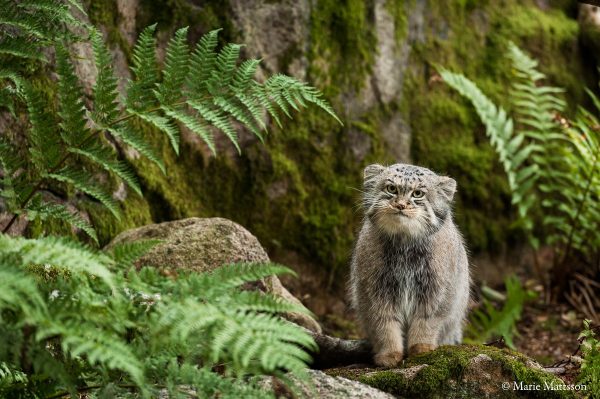In short, the sad (but ecologically sound) truth is no. You can’t keep a Pallas cat as a pet because these are wild cats that thrive in their natural surroundings. Unlike most domestic cats and dogs, the Pallas cat is a solitary creature that doesn’t fancy living with our indoor creature comforts.
Do Pallas’s Cats Make Good Pets? Why It’s Not Even A Good Idea
In the immortal words of Florence Johnston, “Sit done folks, this is going to take a while.” There are so many reasons why it’s not even a good idea to keep a Pallas’s cat as a pet that I don’t even know where to begin. For starters, they are wild animals that are best observed and appreciated in their natural habitats or well-managed conservation programs. They are solitary and territorial animals. This sort of animal does not make for a good companion for you and will cause trauma to the cat. Their average territory can range 2-3 miles (3-5 km). The average home is much smaller and the cat will feel constrained. Such constraints can lead to maladaptive, possibly destructive, behaviors.
Then there is their diet to consider. It can be difficult to meet these cats’ particular dietary needs in a home setting. In the wild, they feed on small mammals and birds. They mostly eat pika, a small mammal that belongs to the same order as rabbits, Lagomorpha. A hungry wildcat might be placated by rabbits, but I wouldn’t put my money on it. Furthermore, although the American pika is native to North America, it can only be found in alpine terrine, or areas above the tree line.
Even if you manage to locate a trustworthy and reliable pika supplier or learn that your pal’s cat is content with rabbits, assuming you’re searching for a companion animal, they won’t be the most interesting pet. In the wild, these cuties sleep most of the day. And the night. Their main activities are hunting, catching, and consuming prey, so these are the times of day when they are most active. Playful animals, these are not. Adapted for survival they are. They are also solitary creatures. You only believe that your tamed short hair is rejecting you.
Do Pallas’s Cats Make Good Pets? What is a Pallas’s Cat?
The manul, or Pallas’s cat (Otocolobus manul), is a small wild cat indigenous to the grasslands and steppes of Central Asia. It is named for the German naturalist Peter Simon Pallas. Pallas first described the species in 1776. Pallas’s cats are built thickly, have a short, flat face, and a long, dense coat that keeps them warm well. Adapted to life in harsh environments, these cats are. These include portions of Central Asia, China, Russia, Iran, and Mongolia’s high-altitude regions.
Pallas’s cats are renowned for their elusive and solitary behavior and are mostly solitary. Since they are crepuscular, the hours of dawn and dusk are when they are most active. They feed on small mammals, birds, and insects. Because of habitat loss, climate change, and poaching, Pallas’s cats are regarded as being in near-threat.

Pallas’s cats feed on small mammals, birds, and insects.
Pallas Cats As Pets?
The short answer is no, Pallas’s cats cannot be kept as pets. Despite their adorable and cuddly appearance, the cats are not suitable to be kept as pets in homes. Small wild felids native to Central Asia, Pallas’s cats are also known as Manuls and are occasionally erroneously referred to as Pallas cats.
Pallas cats are thought to have a grumpy appearance due to their flat, round faces and high-set eyes. Pallas cats’ cute, grumpy faces and shy personalities make them incredibly appealing to a lot of people. They may look grumpy, but beneath their exterior, these are shy, elusive creatures. Without a doubt, these wild cats are not pets despite their unusual appearance and expressive faces making them popular on the internet.
Pallas’s cats are wild creatures, so their requirements and habits are very different from those of house cats. These differences make them unsuitable for pet ownership. They are not adapted to a domestic setting. Furthermore, these cats must stay in their native habitats to support population conservation and guarantee their survival in the wild due to their conservation status as a near-threatened species.
- The wild cats of Pallas are not fit to be kept as pets.
- Their needs and behaviors differ significantly from domesticated cats
- For them to survive, protecting their population in the wild is essential.

Let’s examine the Pallas’s Cats in more detail and discover what makes them special.
The manul, or Pallas’s cat (Felis manul), is a small wild cat with a distinctive appearance. Their fur is dense and long, mostly gray with dark stripes. A Pallas’s cat’s body length varies from 46 to 65 cm, and its weight varies from 2 5 and 4. 5 kg. These cats have a broad head and round ears, which give them a distinctive and expressive appearance.
Pallas’s cats are renowned for being the most reclusive in the world and live alone. and can be quite aggressive when feeling threatened. Like domestic cats, they are known to purr and growl, and they utilize scent marking to communicate with other cats in their territory. Being primarily nocturnal, the Pallas’s cat hunts and is active at night.
Throughout much of Asia, including Mongolia, Central Asia, China, Pakistan, Iran, India, Kazakhstan, Afghanistan, Russia, Kyrgyzstan, Bhutan, and Nepal, these wild cats can be found. Their natural habitat is primarily found in mountainous areas with rocky outcrops at elevations of up to 4,000 meters. Additionally, Siberia, Central China, and Southern Russia are home to Pallas’s cats.
FAQ
Can you legally own a Pallas cat?
Can Pallas cats survive in captivity?
Can we adopt a Pallas cat?
Can Pallas cats purr?